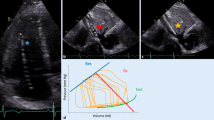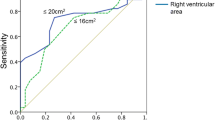Abstract
To assess the contribution of right ventricular (RV) trabeculae and papillary muscles (TPM) to RV mass and volumes in controls and patients with pulmonary arterial hypertension (PAH). Furthermore, to evaluate whether TPM shows a similar response as the RV free wall (RVFW) to changes in pulmonary artery pressure (PAP) during follow-up. 50 patients underwent cardiac magnetic resonance (CMR) and right heart catheterization at baseline and after one-year follow-up. Furthermore 20 controls underwent CMR. RV masses were assessed with and without TPM. TPM constituted a larger proportion of total RV mass and RV end-diastolic volume (RVEDV) in PAH than in controls (Mass: 35 ± 7 vs. 25 ± 5 %; p < 0.001; RVEDV: 17 ± 6 vs. 12 ± 6 %; p = 0.003). TPM mass was related to the RVFW mass in patients (baseline: R = 0.65; p < 0.001; follow-up: R = 0.80; p < 0.001) and controls (R = 0.76; p < 0.001). In PAH and controls, exclusion of TPM from the assessment resulted in altered RV mass, volumes and function than when included (all p < 0.01). Changes in RV TPM mass (β = 0.44; p = 0.004) but not the changes in RVFW mass (p = 0.095) were independently related to changes in PAP during follow-up. RV TPM showed a larger contribution to total RV mass in PAH (~35 %) compared to controls (~25 %). Inclusion of TPM in the analyses significantly influenced the magnitude of the RV volumes and mass. Furthermore, TPM mass was stronger related to changes in PAP than RVFW mass. Our results implicate that TPM are important contributors to RV adaptation during pressure overload and cannot be neglected from the RV assessment.



Similar content being viewed by others
References
McLaughlin VV, McGoon MD (2006) Pulmonary arterial hypertension. Circulation 114(13):1417–1431
Voelkel NF, Quaife RA, Leinwand LA, Barst RJ, McGoon MD, Meldrum DR et al (2006) Right ventricular function and failure: report of a national heart, lung, and blood institute working group on cellular and molecular mechanisms of right heart failure. Circulation 114(17):1883–1891
Pennell DJ, Sechtem UP, Higgins CB, Manning WJ, Pohost GM, Rademakers FE et al (2004) Clinical indications for cardiovascular magnetic resonance (CMR): consensus panel report. Eur Heart J 25(21):1940–1965
Hagger D, Condliffe R, Woodhouse N, Elliot CA, Armstrong IJ, Davies C et al (2009) Ventricular mass index correlates with pulmonary artery pressure and predicts survival in suspected systemic sclerosis-associated pulmonary arterial hypertension. Rheumatology (Oxford, England) 48(9):1137–1142
Roeleveld RJ, Marcus JT, Boonstra A, Postmus PE, Marques KM, Bronzwaer JG et al (2005) A comparison of noninvasive MRI-based methods of estimating pulmonary artery pressure in pulmonary hypertension. J Magn Reson Imaging 22(1):67–72
Saba TS, Foster J, Cockburn M, Cowan M, Peacock AJ (2002) Ventricular mass index using magnetic resonance imaging accurately estimates pulmonary artery pressure. Eur Respir J 20(6):1519–1524
Wilkins MR, Ali O, Bradlow W, Wharton J, Taegtmeyer A, Rhodes CJ et al (2010) Simvastatin as a treatment for pulmonary hypertension trial. Am J Respir Crit Care Med 181(10):1106–1113
Reesink HJ, Marcus JT, Tulevski II, Jamieson S, Kloek JJ, Vonk Noordegraaf A et al (2007) Reverse right ventricular remodeling after pulmonary endarterectomy in patients with chronic thromboembolic pulmonary hypertension: utility of magnetic resonance imaging to demonstrate restoration of the right ventricle. J Thorac Cardiovasc Surg 133(1):58–64
D’Armini AM, Zanotti G, Ghio S, Magrini G, Pozzi M, Scelsi L et al (2007) Reverse right ventricular remodeling after pulmonary endarterectomy. J Thorac Cardiovasc Surg 133(1):162–168
Wilkins MR, Paul GA, Strange JW, Tunariu N, Gin-Sing W, Banya WA et al (2005) Sildenafil versus endothelin receptor antagonist for pulmonary hypertension (SERAPH) study. Am J Respir Crit Care Med 171(11):1292–1297
Frist WH, Lorenz CH, Walker ES, Loyd JE, Stewart JR, Graham TP Jr et al (1995) MRI complements standard assessment of right ventricular function after lung transplantation. Ann Thorac Surg 60(2):268–271
van Wolferen SA, Marcus JT, Boonstra A, Marques KM, Bronzwaer JG, Spreeuwenberg MD et al (2007) Prognostic value of right ventricular mass, volume, and function in idiopathic pulmonary arterial hypertension. Eur Heart J 28(10):1250–1257
Hudsmith LE, Petersen SE, Francis JM, Robson MD, Neubauer S (2005) Normal human left and right ventricular and left atrial dimensions using steady state free precession magnetic resonance imaging. J Cardiovasc Magn Reson 7(5):775–782
Grothues F, Moon JC, Bellenger NG, Smith GS, Klein HU, Pennell DJ (2004) Interstudy reproducibility of right ventricular volumes, function, and mass with cardiovascular magnetic resonance. Am Heart J 147(2):218–223
Lorenz CH, Walker ES, Morgan VL, Klein SS, Graham TP Jr (1999) Normal human right and left ventricular mass, systolic function, and gender differences by cine magnetic resonance imaging. J Cardiovasc Magn Reson 1(1):7–21
Hardziyenka M, Campian ME, Reesink HJ, Surie S, Bouma BJ, Groenink M et al (2011) Right ventricular failure following chronic pressure overload is associated with reduction in left ventricular mass evidence for atrophic remodeling. J Am Coll Cardiol 57(8):921–928
Dibble CT, Lima JA, Bluemke DA, Chirinos JA, Chahal H, Bristow MR et al (2011) Regional left ventricular systolic function and the right ventricle: the multi-ethnic study of atherosclerosis right ventricle study. Chest 140(2):310–316
Sandstede J, Lipke C, Beer M, Hofmann S, Pabst T, Kenn W et al (2000) Age- and gender-specific differences in left and right ventricular cardiac function and mass determined by cine magnetic resonance imaging. Eur Radiol 10(3):438–442
Doherty NE III, Fujita N, Caputo GR, Higgins CB (1992) Measurement of right ventricular mass in normal and dilated cardiomyopathic ventricles using cine magnetic resonance imaging. Am J Cardiol 69(14):1223–1228
Chuang ML, Gona P, Hautvast GL, Salton CJ, Blease SJ, Yeon SB et al (2012) Correlation of trabeculae and papillary muscles with clinical and cardiac characteristics and impact on CMR measures of LV anatomy and function. JACC 5(11):1115–1123
Jacquier A, Thuny F, Jop B, Giorgi R, Cohen F, Gaubert JY et al (2010) Measurement of trabeculated left ventricular mass using cardiac magnetic resonance imaging in the diagnosis of left ventricular non-compaction. Eur Heart J 31(9):1098–1104
Janik M, Cham MD, Ross MI, Wang Y, Codella N, Min JK et al (2008) Effects of papillary muscles and trabeculae on left ventricular quantification: increased impact of methodological variability in patients with left ventricular hypertrophy. J Hypertens 26(8):1677–1685
Weinsaft JW, Cham MD, Janik M, Min JK, Henschke CI, Yankelevitz DF et al (2008) Left ventricular papillary muscles and trabeculae are significant determinants of cardiac MRI volumetric measurements: effects on clinical standards in patients with advanced systolic dysfunction. Int J Cardiol 126(3):359–365
Han Y, Osborn EA, Maron MS, Manning WJ, Yeon SB (2009) Impact of papillary and trabecular muscles on quantitative analyses of cardiac function in hypertrophic cardiomyopathy. J Magn Reson Imaging 30(5):1197–1202
Vogel-Claussen J, Finn JP, Gomes AS, Hundley GW, Jerosch-Herold M, Pearson G et al (2006) Left ventricular papillary muscle mass: relationship to left ventricular mass and volumes by magnetic resonance imaging. J Comput Assist Tomogr 30(3):426–432
Papavassiliu T, Kuhl HP, Schroder M, Suselbeck T, Bondarenko O, Bohm CK et al (2005) Effect of endocardial trabeculae on left ventricular measurements and measurement reproducibility at cardiovascular MR imaging. Radiology 236(1):57–64
Galie N, Torbicki A, Barst R, Dartevelle P, Haworth S, Higenbottam T et al (2004) Guidelines on diagnosis and treatment of pulmonary arterial hypertension. The task force on diagnosis and treatment of pulmonary arterial hypertension of the European society of cardiology. Eur Heart J 25(24):2243–2278
Katz J, Whang J, Boxt LM, Barst RJ (1993) Estimation of right ventricular mass in normal subjects and in patients with primary pulmonary hypertension by nuclear magnetic resonance imaging. J Am Coll Cardiol 21(6):1475–1481
Fulton RM, Hutchinson EC, Jones AM (1952) Ventricular weight in cardiac hypertrophy. Br Heart J 14(3):413–420
Vogel-Claussen J, Shehata ML, Lossnitzer D, Skrok J, Singh S, Boyce D et al (2011) Increased right ventricular septomarginal trabeculation mass is a novel marker for pulmonary hypertension: comparison with ventricular mass index and right ventricular mass. Invest Radiol 46(9):567–575
Madu EC, Baugh DS, Johns C, D’Cruz IA (2001) Papillary muscle contribution to ventricular ejection in normal and hypertrophic ventricles: a transesophageal echocardiographic study. Echocardiography (Mount Kisco, NY) 18(8):633–638
Shors SM, Fung CW, Francois CJ, Finn JP, Fieno DS (2004) Accurate quantification of right ventricular mass at MR imaging by using cine true fast imaging with steady-state precession: study in dogs. Radiology 230(2):383–388
Wenink AC, Gittenberger-de Groot AC (1982) Left and right ventricular trabecular patterns. Consequence of ventricular septation and valve development. Br Heart J 48(5):462–468
Damon BJ, Remond MC, Bigelow MR, Trusk TC, Xie W, Perucchio R et al (2009) Patterns of muscular strain in the embryonic heart wall. Dev Dyn 238(6):1535–1546
Fransson P, Merboldt KD, Petersson KM, Ingvar M, Frahm J (2002) On the effects of spatial filtering—a comparative fMRI study of episodic memory encoding at high and low resolution. Neuroimage 16(4):977–984
Roberts WC, Cohen LS (1972) Left ventricular papillary muscles. Description of the normal and a survey of conditions causing them to be abnormal. Circulation 46(1):138–154
Goo S, Joshi P, Sands G, Gerneke D, Taberner A, Dollie Q et al (2009) Trabeculae carneae as models of the ventricular walls: implications for the delivery of oxygen. J Gen Physiol 134(4):339–350
Ruiter G, Ying Wong Y, de Man FS, Louis Handoko M, Jaspers RT, Postmus PE et al (2013) Right ventricular oxygen supply parameters are decreased in human and experimental pulmonary hypertension. J Heart Lung Transplant 32(2):231–240
Winter MM, Bernink FJ, Groenink M, Bouma BJ, van Dijk AP, Helbing WA et al (2008) Evaluating the systemic right ventricle by CMR: the importance of consistent and reproducible delineation of the cavity. J Cardiovasc Magn Reson 10:40
Sievers B, Kirchberg S, Bakan A, Franken U, Trappe HJ (2004) Impact of papillary muscles in ventricular volume and ejection fraction assessment by cardiovascular magnetic resonance. J Cardiovasc Magn Reson 6(1):9–16
Bradlow WM, Hughes ML, Keenan NG, Bucciarelli-Ducci C, Assomull R, Gibbs JS et al (2010) Measuring the heart in pulmonary arterial hypertension (PAH): implications for trial study size. J Magn Reson Imaging 31(1):117–124
Bloomgarden DC, Fayad ZA, Ferrari VA, Chin B, Sutton MG, Axel L (1997) Global cardiac function using fast breath-hold MRI: validation of new acquisition and analysis techniques. Magn Reson Med 37(5):683–692
McDonald KM, Parrish T, Wennberg P, Stillman AE, Francis GS, Cohn JN et al (1992) Rapid, accurate and simultaneous noninvasive assessment of right and left ventricular mass with nuclear magnetic resonance imaging using the snapshot gradient method. J Am Coll Cardiol 19(7):1601–1607
Acknowledgments
T. Kind was supported by the Netherlands Organisation for Scientific Research (NWO), Toptalent grant, project number 021.001.120. A. Vonk-Noordegraaf was supported by the NWO, Vidi Grant, Project number 91.796.306.
Conflict of interest
None.
Author information
Authors and Affiliations
Corresponding author
Rights and permissions
About this article
Cite this article
van de Veerdonk, M.C., Dusoswa, S.A., Tim Marcus, J. et al. The importance of trabecular hypertrophy in right ventricular adaptation to chronic pressure overload. Int J Cardiovasc Imaging 30, 357–365 (2014). https://doi.org/10.1007/s10554-013-0338-z
Received:
Accepted:
Published:
Issue Date:
DOI: https://doi.org/10.1007/s10554-013-0338-z




